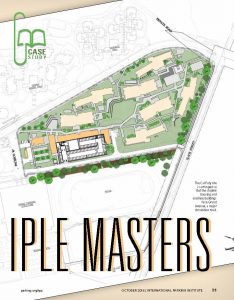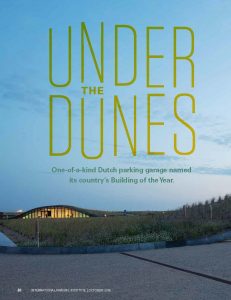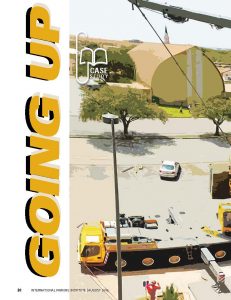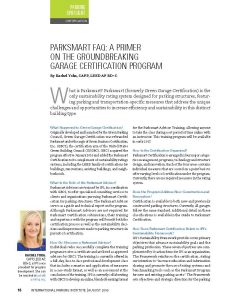BEAUTY AND A FUNCTIONAL BEAST
Form and function meet in Sarasota’s State Street Parking Garage
When Sarasota, Fla.’s city planners decided to develop a new parking structure, they saw it as an essential element of the city’s drive to promote economic growth. In fact, the city’s downtown parking master plan is largely designed to enhance the vitality of downtown development by encouraging visitors and employees of local businesses to park in centrally located garages and lots and use pedestrian ways to reach their ultimate destinations. The six-story, 397-space State Street Parking Garage is the second of a series of parking facilities planned for downtown Sarasota.
Ultimately, the parking master plan will provide city planners the flexibility to re-align or reduce the number of on-street parking spaces to increase sidewalk widths and pedestrian activity areas. Also, by centralizing parking, the plan minimizes the amount of parking area businesses need to develop to meet their needs. As a result, developers and building owners can focus their development investments on creating income-producing commercial and residential space rather than parking. In addition to supporting local businesses, this element of the parking master plan is also leading to the development of lower, more attractive, and more functional buildings.
Sarasota’s plan provides a terrific example of how strategic parking planning can help make cities more walkable, business-friendly, and congestion-free. In addition to providing wider sidewalks for pedestrians, the city’s plan also increases and improves landscaping downtown, provides new benches for visitors, and permits restaurants to provide outdoor services on the newly widened sidewalks.
Safe, More Convenient Parking In light of the important role parking is to play in Sarasota’s downtown plan, the primary goal of designers was to create a facility parkers would want to use. This was no small feat, considering the site’s small footprint. The site’s depth of just 105 feet with a 20-foot-wide alley created a significant design challenge. Not only did designers need to create a functional, parker-friendly facility on this small footprint, but they had to do so in a way that would support the development of a planned multi-level office or residential liner building that will be built on an adjacent site to the west of the garage. The design also needed to accommodate a 58,000 gallon stormwater detention vault, which was ultimately tucked under the ramp at ground level.
Finally, the design needed to accommodate the future implementation of a renewable energy program. To this end, the project’s parking consultants from Walker Parking included in the design the necessary infrastructure for the future installation of a photovoltaic system above the top parking level.
The functional design resulted in a two-bay-wide, six-level-high, single-threaded helix structure with parking on one flat bay and one ramped bay. With the exception of two spaces at ground level, that are compliant with the Americans with Disabilities Act, all 397 spaces are provided on the elevated floors and provide parking for visitors and employees of local downtown businesses. The deck’s footprint is 298 feet by 105 feet, and site boundary constraints resulted in only one row of parking being included at the ramps. The garage’s columns are typically spaced at 24 feet on center, with 48 feet at the end of bays. The north parking bay is 60 feet wide, and the south ramp bay is 45 feet wide.
Traffic flow is always a challenge in such small footprints. The consultant was able to achieve two-way flow with 9-foot by 18-foot, 90-degree stalls. These dimensions permit safe and convenient traffic flow combined with convenient parking. The typical floor-to-floor height is 10 feet, six inches, except at the ground level, which is 17 feet high to accommodate the 14,000-square-foot ground-level retail shell with a loading dock at the back of the structure. The 10-foot-high ceilings on the parking levels offer a more comfortable, customer-friendly parking experience while enhancing safety by improving visibility throughout the structure.
Access to the garage from State Street on the north is provided by an entry/exit on the east end of the deck. A second entry/exit on the east end is provided from Ringling Boulevard to the south through a 150-foot-long, two-way driveway to the garage. This driveway also
provides access to the alley bordering the south side of the structure, allowing access to the loading dock and utilities beneath the ramp. To allow tight turns for large trucks into the alley, traffic flow in the alley is one way, from east to west.
Pedestrian flow was also an essential design element. To provide the safest and most convenient experience, pedestrians are directed to two separate elevator and stair towers, one at the northwest corner of the deck and the other on the north side near the State Street entrance.
Two final design elements revolved around lighting and security. When it came to lighting, the primary focus of the electrical design was energy efficiency. Designers selected LED light fixtures arranged in locations to provide good light uniformity, exceeding Illuminating Engineering Society standards and providing a safer, more customer-friendly, and more energy-efficient experience. A lighting control system comprised of timers and photo cells further enhances energy efficiency by permitting parking operators to tailor lighting requirements around peak utilization and other considerations. The electrical system is backed up by an uninterrupted power system that provides energy for the emergency lights, and additional safety features include a surge protection system, emergency phone assistance stations, and an elevator recall system.
The electrical design also supports the city’s goal of promoting sustainable energy use with the addition of four electric vehicle charging stations. These stations are located near the northwest stair and elevator tower at the second level.
Security was an equally important design consideration. Passive security features include open stair towers with emergency phones. In addition, the interior of the deck, the stair towers, and the ground-level perimeter are well-illuminated to improve visibility throughout the facility. The design also includes infrastructure to permit future expansion of security elements, including the installation of a conduit for future security cameras at the lobbies of the stair elevator towers and multiple locations throughout the deck.
Tampa-based general contracting firm A.D. Morgan oversaw the construction of the garage, working closely with the development team, the city, and neighboring businesses. The garage structure is cast-in-place post-tensioned slabs, beams, and girders supported on a drilled shaft foundation system. The ground level is slab-on-grade construction placed on compacted fill. The structure’s stair and elevator towers are cast-in-place with conventionally reinforced walls, slabs, and beams with a structural steel gable-framed roof.
Form Meets Function
The State Street Garage’s architecture was a key element of its design. Because of its central downtown location, the garage needed to be attractive as well as functional. As a Sarasota-based architect, Harvard Jolly Architects was intimately familiar with the character of downtown Sarasota and able to design a structure that fits seamlessly—and beautifully—with its neighbors.
The garage’s attractive design presents the classical look of a residential apartment building that perfectly complements the surrounding buildings. The primary north facade along State Street is expressed with precast architectural panels with accented bands around window openings and 12-inch-deep sill ledges with dentils.
The main vehicle entry from State Street is the garage’s architectural focal point. It features precast architectural panels with arches and articulated stone veneers at vehicle and pedestrian entrances. Column panels with column capitals and bases are set in front of the precast panels. The east end of the building is block infill between the horizontal cast-in-place beams, and the east face has a stucco finish with custom foam shapes with polyurethane hard coat for columns, capitals, window surrounds, and cornices. The west elevation of the garage is masonry block infill panels between horizontal cast-in-place beams and vertical columns with no openings or trim to abut the future adjacent liner building.
The structure’s ground floor is designed to house future retail establishments, and the exterior architecture is designed to appeal to customers of these establishments while complementing the rest of the building. Continuous glazing along the ground floor and a combination of canopies and brick pavers for sidewalks with landscaping achieve a presentation that’s accessible and welcoming for pedestrians.
A final architectural accent is provided through landscape architecture. The design, which was created by Sarasota-based David Johnston Architects, features a combination of palm trees, shrubs, and deciduous trees to provide an attractive, welcoming environment outside of the parking facility.
Well-Earned Recognition
The State Street Garage has been well-received locally and is already considered a Sarasota landmark. It has also achieved wider recognition, having won two awards from the Florida Parking Association (FPA): the 2015 FPA Award of Merit for Parking Structure Architecture and the 2015 Award of Merit for Parking Structure Design.
BILL SMITH, APR, is principal of Smith-Phillips Strategic Communications. He can be reached at bsmith@smith-phillips.com or 603.491.4280
TPP-2016-10-Beauty and a Functional Beast
 By Rita Pagan, DES
By Rita Pagan, DES
 By Chris Elliston
By Chris Elliston







